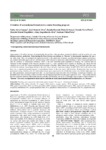Please use this identifier to cite or link to this item:
http://www.alice.cnptia.embrapa.br/alice/handle/doc/1036062| Title: | Evolution of aerenchyma formation in a maize breeding program. |
| Authors: | CAMPOS, N. A.  ALVES, J. D.   SOUZA, K. R. D. de   PORTO, B. N.   MAGALHAES, M. M.   SILVA, G. J. da   PAIVA, L. V.   |
| Affiliation: | Nádia Alves Campos, Catholic University of Leuven; José Donizeti Alves, UFLA; Kamila Rezende Dázio de Souza, UFLA; Brenda Neves Porto, UFLA; MARCELO MURAD MAGALHAES, CPATU; Glacy Jaqueline da Silva, UFPEL; Luciano Vilela Paiva, UFLA. |
| Date Issued: | 2016 |
| Citation: | Plant Omics Journal, v. 9, n. 1, p. 19-25, 2016. |
| Description: | Approximately 28 million hectares of intermittently flooded land with agricultural potential in Brazil could be used for rice crop rotation to increase production. Understanding the flood tolerance mechanisms in "Saracura" is of paramount importance for maize and other crops. Thus, we evaluated the expression levels of the superoxide dismutase, ascorbate peroxidase, guaiacol peroxidase, and catalase antioxidant genes and cell wall loosening (XET) enzyme in maize roots under flooding as well as associated expression with the initiation of aerenchyma formation, which is the most important plant adaptation to flooding. We collected data on "Saracura" at the beginning of the breeding program (cycle 1), a time considered more sensitive to flooding, and during the last selection cycle (cycle 18), a time considered more resistant to flooding. Maize plants were flooded for 12 and 24h, and roots were collected for anatomic (aerenchyma density in the root cortex) and gene expression analyses by qRT-PCR. Our results showed that there was a proportional graded increase in aerenchyma formed in the root cortex with increased flooding time that was most pronounced during selection cycle 18. Antioxidant enzyme gene expression levels at both time points were similar: high expression just after germination, decreased expression after 12h, and increased expression after 24h of flooding. Aerenchyma formation was detectable after 24h of flooding, which coincided with the highest antioxidant enzyme gene expression levels. These results indicate that the correlation between antioxidant enzyme activities and flooding can act as a molecular flag to improve flood tolerance in "Saracura". Our results are important to understand the induction of aerenchyma formation and flooding tolerance in "Saracura". |
| Thesagro: | Milho Melhoramento |
| Type of Material: | Artigo de periódico |
| Access: | openAccess |
| Appears in Collections: | Artigo em periódico indexado (CPATU)  |
Files in This Item:
| File | Description | Size | Format | |
|---|---|---|---|---|
| Campos2016.pdf | 454,64 kB | Adobe PDF |  View/Open |









